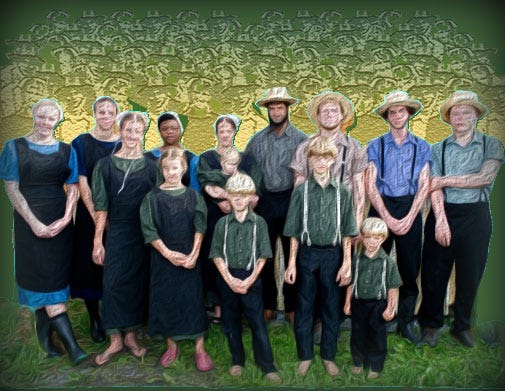The Great Pause Week 39: Amish Mash
" John Miller’s family was not unusually large. It is just that he lived long enough to find out what simple multiplication does"
Recently, on the eve of his 95th birthday, John Eli Miller died in a rambling farmhouse near Middlefield, Ohio, 40 miles southeast of Cleveland, leaving to mourn his passing perhaps the largest number of living descendants any American has ever had.
He was survived by five of his seven children, 61 grandchildren, 338 great-grandchildren and six great-great-grandchildren, a grand total of 410 descendants.
Shortly before his death, which came unexpectedly from a stroke, I had the privilege of two long visits with John E. Miller, during which I learned the feeling of one man who had personally watched the population explosion of the 20th century. A national magazine had determined that the venerable Ohio farmer was head of what almost certainly was the largest family in the United States.
A Swedish newspaper in 1958 ran a competition for the largest family in that country and when a family named Hellander turned up with 265 members, headed by a 92-year-old great- grandmother, it asserted a claim to the Swedish and to the world championship.
Soon reports of even larger families were streaming in to editors, with an elderly Mormon couple in Utah claiming 334 living descendants taking the lead. However, I was certain that among the Old Order Amish Mennonites, a sect in which families of more than 100 are commonplace, a family larger than this could be found. Through the medium of the Sugarcreek Ohio Budget, a unique weekly newspaper that is read by the Old Order Amish in all their communities throughout the nation, it was soon ascertained that John Eli Miller, with his clan of more than 400, had the largest family among them. So far as could be learned, this family was the largest in America and probably the world’s largest among monogamous peoples.
When John Miller and his family refused to pose for photographs because of their religious opposition to “graven images,” the magazine gave up the idea of a story about this “largest family” but the interviews disclosed a number of facts about the impact of extremely rapid population growth on this family and the cultural group of which it is a part. These facts merit the serious attention of all students of population problems.
PERSONAL POPULATION CRISIS
John Miller actually had seen with his own eyes a population explosion in his own lifetime. His data were not statistics on a graph or chart, but the scores of children at every family gathering who ran up to kiss Grandpa, so many that it confused a poor old man. His confusion can be forgiven for there were among them no less than 15 John Millers, all named in his honor. And what young man, much less an old one, could remember the names of 61 grandchildren and 338 great-grandchildren and keep straight just who their parents were?
The remarkable thing about this great clan of his was that it started with a family of just seven children. This was actually a little smaller than the typical family among the Amish, who have been found by one researcher to average 8.4 children per completed family. Two of his children died in early life: Samuel Miller, who left six children when he died at 40, and Lizzie (Mrs. Jacob Farnwald), who left four when she died at 28.
During most of his long life, therefore, John Miller’s family was not unusually large. It is just that he lived long enough to find out what simple multiplication can do.
One of his daughters, Mary (Mrs. Jacob Mast), had only five children. But all four of his sons had quite large families. His son, John, Jr., with whom he lived at the family homestead, had six children by his first wife, who died in an accident, and nine more by his present wife, a total of 15. Andrew Miller had 12, Eli Miller, 11, of whom ten are living, and Joseph Miller, ten, of whom nine are living.
Of the 63 grandchildren born to John Miller’s family, 61 lived to survive him, all but six now grown and married. And of 341 great-grandchildren born to the families of his 55 married grandchildren, only three had died, two in infancy, and one in an accident. All six of his great-great-grandchildren were born during the last year of his life and were healthy infants.
MODERN MEDICINE PROLONGS LIFE
Thus, a major factor in the world-wide population crisis was vividly evident in John Miller’s family: the fact that nearly all children born in the 20th century, who enjoy the benefits of modern medicine, are growing up to become adults and to have families of their own. A century ago, the ravages of smallpox, typhoid fever, tuberculosis, diphtheria and the many fatalities that occurred at childbirth would have left a far different picture in a large rural family. Even though the Amish live in rural areas, they avail themselves of the benefits of medical care. Now most Amish children are born in hospital delivery rooms.
While the sharp reduction in infant mortality and childhood disease is a happy development of science, it inevitably means that population grows with extraordinary rapidity. The Miller family offers a cogent example. John Miller had seven children; his children averaged nine offspring; and his married grandchildren had averaged six each when he passed away. Six married great-grandchildren had one apiece. These were not unusually large families among the Amish nor among the rural families of other Americans in the past century. Yet this clan numbered 410 when John Miller died.
Moreover, at the end of his life, the postman was bringing John Miller word of the birth of a new descendant on the average of once every ten days. This rate, we calculated, would have accelerated to one every other day as his more than 300 great-grand- children reached marriageable age. Only eight were married when he died and six had had children by their first wedding anniversaries.
So great is the rate of progression of population growth that had John Miller lived one more decade he would have seen more descendants born to him than in all his 95 years of life and would in ten more years have counted at least 1,000 living descendants!
The rate at which population increases is almost unbelievable- even when a man is watching it happen within his own family. John Miller found it difficult to comprehend what was happening. When I told him that all available evidence indicated that he had the largest family in the United States, the kindly old man passed a gnarled hand before his failing eyes and shook his head in amazement. . . .
What did John Miller think about his family? Did it worry him to see it growing so large? Indeed it did. Significantly, his concerns were the very ones that the demographers, the economists, the sociologists, and other serious students of world population problems have been voicing. He was not an educated man, for the Amish still believe eight grades of education in a one-room country school is sufficient, but John Miller summarized it in one simple question he constantly repeated, “Where will they all find good farms?” . . .
Some day, at some point, John Miller’s plaintive question, “Where will they all find farms?” will have to be answered in the bleak negative. They can continue now only by buying farms others will sell them. Some day no more farms anywhere will be for sale. A finite world is of limited size. So, ultimately, at some point, is the population it can hold.
REDUX
The foregoing essay originally appeared in 1961 in Population Bulletin, a monthly publication of the Population Reference Bureau of Washington DC. The author was the late Glenn D. Everett and the essay was later reprinted in Garrett Hardin’s annotated collection, Population, Evolution, Birth Control (1964).
Last week I described the Green Revolution, for which Norman Borlaug was awarded the Nobel Peace Prize in 1970. While the technological industrialization of agriculture has to many seemed a major advance for our species, we ignore the disturbance it has wrought upon nature at our peril. It has become a familiar canard that the greening of agriculture as we march into the future, with organic, biodynamic, regenerative, permaculturally designed, vertical, and “sustainable” alternatives making greater market inroads every year, cannot possibly keep pace with population growth and so industrial agriculture must remain much as it is, gradually becoming more efficient and productive, into the uncertain and perilous future.
What seems to be neglected in that pronouncement is that industrial agriculture can no more feed 8 billion people than can organic farming. That was Malthus’s point.
If the subsistence for man that the earth affords was to be increased every twenty-five years by a quantity equal to what the whole world at present produces, this would allow the power of production in the earth to be absolutely unlimited, and its ratio of increase much greater than we can conceive that any possible exertions of mankind could make; yet still the power of population being a power of a superior order, the increase of the human species can only be kept commensurate….
— Malthus, T.R. 1798. An Essay on the Principle of Population
Humanity, despite many noble but half-hearted attempts over the past century, has been unwilling to hold its increase in line with the power of production in the earth. That unwillingness appears to be hard wired. So too are the boundaries of what Earth can supply or insults that it can absorb. A reckoning beckons. Push-back from the microbial world is only one of many auguries.
___________
The COVID-19 pandemic has destroyed lives, livelihoods, and economies. But it has not slowed down climate change, which presents an existential threat to all life, humans included. The warnings could not be stronger: temperatures and fires are breaking records, greenhouse gas levels keep climbing, sea level is rising, and natural disasters are upsizing.
As the world confronts the pandemic and emerges into recovery, there is growing recognition that the recovery must be a pathway to a new carbon economy, one that goes beyond zero emissions and runs the industrial carbon cycle backwards — taking CO2 from the atmosphere and ocean, turning it into coal and oil, and burying it in the ground. The triple bottom line of this new economy is antifragility, regeneration, and resilience.
Help me get my blog posted every week. All Patreon donations and Blogger subscriptions are needed and welcomed. You are how we make this happen. Your contributions are being made to Global Village Institute, a tax-deductible 501(c)(3) charity. PowerUp! donors on Patreon get an autographed book off each first press run. Please help if you can.



Comments